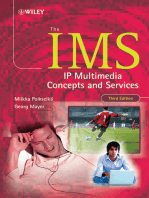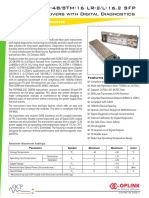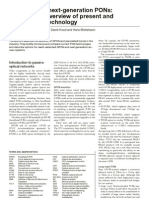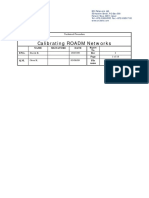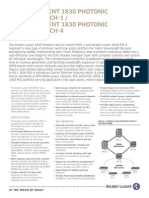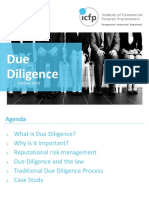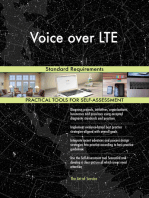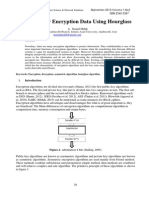Tutorial Internet and Service
Uploaded by
Anonymous N22g3i4Tutorial Internet and Service
Uploaded by
Anonymous N22g3i41 c:/My Documents/iscc2004-tut3.ppt Copyright (C) 2004. All Rights Reserved. J.
Ghetie 7/7/2004
Internet
Internet
Network and Service Management
Network and Service Management
ISCC 2004
ISCC 2004
-
-
Tutorial # 3
Tutorial # 3
-
-
Joseph Ghetie
phone 201-592-6419
fax 201-585-8637
email: joe.ghetie@verizon.net
Web: www.ghetie.com/tcom
TCOM & NET, 2200 N. Central Rd. Suite 5G, Fort Lee, NJ 07024, USA
2 c:/My Documents/iscc2004-tut3.ppt Copyright (C) 2004. All Rights Reserved. J.Ghetie 7/7/2004
Internet Network and Service Management
NOTICE OF DISCLAIMER
TCOM & NET does not provide comparative analysis or evaluation of products or
suppliers. Any mention of products or suppliers in this presentation is done where
necessary for the sake of scientific accuracy and precision, or for background
information to a point of technology analysis, or to provide an example of a
technology for illustrative or clarification purposes and should not be construed as
either positive or negative commentary on that product or supplier. Neither should
the inclusion of a product or a supplier in this presentation, nor the omission of a
product or supplier on the part of the author or of TCOM & NET does not make
any purchasing recommendations. No endorsement of any vendor or product is
intended.
International Symposium on Computer Communications, ISCC 2004, June 28-July 1, 2004, Alexandria, Egypt
3 c:/My Documents/iscc2004-tut3.ppt Copyright (C) 2004. All Rights Reserved. J.Ghetie 7/7/2004
PURPOSE
To analyze Internet network and service management concept, models, architectures, the criteria and
attributes associated with Quality of Services, Classes of Services, and Service Level Specifications/
Agreements, and the state of management products to provide solutions and applications focused on
Internet network and service management.
TUTORIAL LEVEL
Intermediate/Advanced. It assumes basic understanding of networking and management concepts as
applied to major networking technologies, including the Internet network environment.
WHO WILL BENEFIT BY ATTENDING
Management information systems, data communications and telecommunications staff, software
developers, network and service providers, analysts, consultants, and managers seeking
understanding of management services and management applications and management platforms
associated with service management layer.
Internet Network and Service Management
International Symposium on Computer Communications, ISCC 2004, June 28-July 1, 2004, Alexandria, Egypt
4 c:/My Documents/iscc2004-tut3.ppt Copyright (C) 2004. All Rights Reserved. J.Ghetie 7/7/2004
OUTLINE OUTLINE
Introduction
1. Internet Network Management Architectures and Applications
1.1 Internet architectures and protocols
1.2 Internet network and systems management architectures
1.3 Internet network management products and applications
2. Service Management Concept, QOS, and SLA
2.1 Service and service management concepts
2.2 Quality of Service (QOS) model and metrics
2.3 Service Level Agreement (SLA) methodology and attributes
3. Internet Service Management Architecture and Applications
3.1 Internet services and classes of services
3.2 Internet service providers
3.3 Internet service management products and applications
4. Issues and Trends in Internet Service Management Implementation
International Symposium on Computer Communications, ISCC 2004, June 28-July 1, 2004, Alexandria, Egypt
5 c:/My Documents/iscc2004-tut3.ppt Copyright (C) 2004. All Rights Reserved. J.Ghetie 7/7/2004
1. Internet Network Management Architectures and
Applications
1.1 Internet network architectures and protocols 1.1 Internet network architectures and protocols
Internet TCP/IP Internet TCP/IP- -based network architecture based network architecture
New Internet network architecture New Internet network architecture
Internet TCP/UDP/IP protocol data framing Internet TCP/UDP/IP protocol data framing
1.2 Internet network management architecture 1.2 Internet network management architecture
Internet network management conceptual model Internet network management conceptual model
Internet SNMP protocol data framing and operations Internet SNMP protocol data framing and operations
Internet network management Internet network management
1.3 Internet network management products and applications 1.3 Internet network management products and applications
Internet management evolution Internet management evolution
Internet management domains Internet management domains
Major commercial management platforms Major commercial management platforms
6 c:/My Documents/iscc2004-tut3.ppt Copyright (C) 2004. All Rights Reserved. J.Ghetie 7/7/2004
Traditional Public/Private Communication Network Model
Any traditional service-oriented public/private network can be described as a mesh of
network structures consisting of access networks, connectivity networks where services are
offered, and core connectivity backbone networks. These networks may belong to multiple
national and international jurisdictions. Individual end-points or whole enterprise internal
networks are considered Customer Premises Equipment/Network and represent the source and
destination of information.
Backbone
Core Connectivity
Networks
Access Networks
Connectivity Networks
End-Points
Customer Premises
Equipment
Enterprise Internal Network
Service
POPs
Service
POPs
7 c:/My Documents/iscc2004-tut3.ppt Copyright (C) 2004. All Rights Reserved. J.Ghetie 7/7/2004
Traditional Internet
For more than a decade, Internet has grown as a hierarchical structure having at the core a
high speed backbone network accessed by major regional networks each of them consisting of
a constellation of connected university networks, all of them representing autonomous systems.
Internet Backbone Network
Regional
Network
Regional
Network
Regional
Network
Regional
Network
Regional
Network
Regional
Network
University
Network
University
Network
University
Network
University
Network
University
Network
University
Network
University
Network
University
Network
University
Network
University
Network
University
Network
University
Network
University
Network
University
Network
University
Network
University
Network
8 c:/My Documents/iscc2004-tut3.ppt Copyright (C) 2004. All Rights Reserved. J.Ghetie 7/7/2004
New Internet Network Architecture
Internet has also evolved from a research/education to a commercial service-based network.
The tremendous growth of the past 5 years is stressing its limits in addressing capacity and
overall security.
Regional
Network Access
Point (W)
Regional
Network Access
Point (E)
Regional
Network Access
Point (E)
Regional
Network Access
Point (C)
ISP
ISP
ISP
ISP
ISP
ISP
ISP
ISP
Internet NSF Backbone Network
AT&T
Backbone Network
MCI/Worldcom
Backbone Network
Sprint
Backbone Network
AOL
Backbone Network
ISP
ISP
ISP
ISP
ISP
ISP
ISP
ISP
ISP
Latin America
Network Access
Point (C)
ISP
ISP
ISP
Other International
Network Access
Points (C)
9 c:/My Documents/iscc2004-tut3.ppt Copyright (C) 2004. All Rights Reserved. J.Ghetie 7/7/2004
USA NSFnet vBNS Internet Layout
The early National Science Foundation (NSF) network that played a crucial role in Internet
development has evolved into NSF Very-high-performance Backbone Network Service
(vBNS), essentially a combination of OC-3/STS-1 (155 Mbps) and OC-12/STS-4 (622 Mbps)
with later migration toward OC- 48 and OC-192 (2.5 Gbps -10 Gbps) based infrastructure.
There are 12 Points of Presence (POPs) in MCI Worldcom central offices and four POPs in
dedicated Supercomputer Centers.
Seattle
San Francisco
Los Angeles
San Diego
Supercomputer Center
Denver
National Center for
Atmospheric Center
Houston
Atlanta
Chicago
National Center
for Supercomputing
Applications
Washington
DC
New York
Boston
Cleveland
Pittsburgh
Supercomputing
Center
OC-12 (622 Mbps)
SBC
Metropolitan
Fiber System
(MFS)
OC-3 (155 Mbps)
Network Access
Point (NAP)
Qwest
Sprint
Bell South
Miami
NAP of the
Americas
Perryman
MD
Point of Presence
10 c:/My Documents/iscc2004-tut3.ppt Copyright (C) 2004. All Rights Reserved. J.Ghetie 7/7/2004
Internet TCP/IP-based Network Architecture
WAN
Backbone Network
Mainframe
Token Ring
ISP
NAP
R
R
LAN
LAN
LAN
R
FDDI
WS
ISP
NAP
PBX
WS
FEP
ISP
NAP
ISP
NAP
ISP
NAP
Internet Service
Providers
CC CC CC
VAX
WS
WS
Currently, the Internet is a three-tier router-based architecture that consists of a backbone network,
connectivity networks, and the enterprise Intranet network environments.
The connectivity network, built around Internet Service Providers (ISPs) Network Access Points
(NAPs), interconnects Intranets/individual subscribers through the access networks to the backbone
network, a high speed WAN using a combination of T3, FR, ATM, SONET, and WDM technologies.
Hub
WS PC
PC PC
Server
Bridge
PC
PC
Server LAN
Hub
R
Server
LAN
INTRANET
FW
FW
ISP
NAP
Metropolitan
Area Exchange
11 c:/My Documents/iscc2004-tut3.ppt Copyright (C) 2004. All Rights Reserved. J.Ghetie 7/7/2004
Internet TCP/IP-based PDU Encapsulation
The user data provided by communication software is encapsulated as it goes down the
protocol stack by adding, in the form of headers, information pertinent to each layer.
The opposite process, decapsulation, takes place at the reception of a PDU, where each
layer strips the message and analyzes the corresponding header information.
Internet
Client/Server
Ethernet
Driver (NIC)
IP
TCP
Internet
Application
Protocol
(e.g., telnet, ftp)
Ethernet connection
User Data
Ethernet
header
IP
header
TCP
header
App.
header
User Data
Application Data
TCP
header
Application Data
IP
header
TCP
header
Application Data
14 bytes 20 bytes 20 bytes 46-1500 bytes
Ethernet frame
IP Datagram
TCP Segment
Application Message
Ethernet
trailer
4 bytes
12 c:/My Documents/iscc2004-tut3.ppt Copyright (C) 2004. All Rights Reserved. J.Ghetie 7/7/2004
1 2 3 8 7 6 5 4 1 2 3 8 7 6 5 4 1 2 3 8 7 6 5 4 1 2 3 8 7 6 5 4
version
4 bits
IHL
4 bits
Type of Service (TOS)
8 bits
Total length
16 bits
Identification (unequivocally)
16 bits
flag
3 bits
Fragment offset
13 bits
Time to Live (TTL)
8 bits ( # of hops)
Transport Protocol
8 bits
Header Checksum
16 bits
Source address
32 bits
Destination address
32 bits
Options
variable (less than 32 bits)
Padding
variable (together with Options 32 bits)
User Data
variable length(depends on the size of Maximum Transmit Unit accepted for a medium)
data field and header maximum 65,535 octets
Internet Protocol Version 4 Format
Internet Protocol (IP) is the Internet Network Layer connectionless datagram protocol.
IP routers may fragment datagrams while end-systems reconstruct fragmented datagrams.
IP datagrams are delivered to the in-header IP destination addresses.
Bits
13 c:/My Documents/iscc2004-tut3.ppt Copyright (C) 2004. All Rights Reserved. J.Ghetie 7/7/2004
Transmission Control Protocol and User Datagram Protocols
1 2 3 8 7 6 5 4 1 2 3 8 7 6 5 4 1 2 3 8 7 6 5 4 1 2 3 8 7 6 5 4
Destination Port (e.g., 25 smtp, 69 tftp)
16 bits
Window
16 bits
Checksum
16 bits
Options
variable (less than 32 bits)
Padding
variable (together with Options 32 bits)
Source Port (e.g., 23 telnet, 21 ftp)
16 bits
Sequence Number
32 bits
Acknowledgment Number
32 bits
Urgent Pointer
16 bits
Header Length
4 bits
Reserved
6 bits
Flags
6 different 1-bit
Destination Port (e.g. , 25 smtp, 69 tftp)
16 bits
Source Port (e.g., 23 telnet, 21 ftp)
16 bits
Checksum
16 bits
Length
16 bits
TCP
UDP
Transmission Control Protocol (TCP) is the connection-oriented Transport Layer protocol.
User Datagram Protocol (UDP) is the connectionless Transport Layer counterpart.
Sockets (logical port number and IP address) are used to map applications into TCP/IP or
UDP/IP protocols. Distinct port numbers are allocated for TCP and UDP-based applications.
bits
14 c:/My Documents/iscc2004-tut3.ppt Copyright (C) 2004. All Rights Reserved. J.Ghetie 7/7/2004
Internet Management Conceptual Model
MAPI - Management Applications Programming Interface
MPEI - Management Platform External Interface
Management
Applications
MAPI
Management
Platform
Management
Applications
MAPI
Management
Platform
Agent
Application
MAPI
Agent
Platform
Manager
Agent
Manager
MPEI
MPEI
Internet networks management is based on manager-agent paradigm and use of management
platforms and open standardized external interfaces.
15 c:/My Documents/iscc2004-tut3.ppt Copyright (C) 2004. All Rights Reserved. J.Ghetie 7/7/2004
Models and Sub-models of the Manager-Agent Paradigm
Management Policies,
Domains, Roles,
Cooperation, Services
Operator
User Interface
Commands
Responses
Communications Interface
Management Protocol
Manager-Agent
boundary
Communications
model
Informational
model
Service
model
Operational
model
Functional
model
Agent
Manager
Management
Functionality
Management
Functionality
MIB
MIB
Notifications
The Manager-Agent architectural relationship is detailed by several specific sub-models.
There is a close relationship between communications, information, and functional models. .
Managed Resources
16 c:/My Documents/iscc2004-tut3.ppt Copyright (C) 2004. All Rights Reserved. J.Ghetie 7/7/2004
Internet Simple Network Management Protocol-based Diagram
WAN
Backbone Network
Mainframe
Token Ring
Bridge
ISP
LAN LAN
LAN
R
FDDI
WS
ISP
PBX
WS
FEP
ISP
ISP
Internet Service
Providers
Bridge
CC CC CC
VAX
WS
PC
Internet SNMP-based management assumes that the managed agents are IP-addressable nodes.
To manage network or systems resources, each managed node should include a SNMP agent.
A A
SNMP Agent SNMP Agent
A A
A A
A A
A A
R
R
Hub
A
A A
PC
PC
PC
PC
A A
A A
Management
Station
A A
A
17 c:/My Documents/iscc2004-tut3.ppt Copyright (C) 2004. All Rights Reserved. J.Ghetie 7/7/2004
Simple Network Management Protocol Stack
Management Applications
Simple Network Management Protocol (SNMP) is an application layer protocol running on
top of the User Datagram Protocol (UDP) Transport Layer protocol and the Internet Protocol
(IP) Network Layer protocol.
Manager
SNMP
UDP
IP
Data link
LLC
MAC
Physical Layer
Agent Application
Agent
SNMP
UDP
IP
Data link
LLC
MAC
Physical Layer
Network
Managed Resources
18 c:/My Documents/iscc2004-tut3.ppt Copyright (C) 2004. All Rights Reserved. J.Ghetie 7/7/2004
SNMP-based Manager-Agent Services and Operations
Manager
(version 1)
Agent
(version 1)
MIB
Get Request
Get Response
Set Request
Get Response
Get-Next Request
Get Response
Traps Version 1
SNMP Version 1-based network management uses four types of basic operations: Get,
Get-Next, Set, and Traps.
Three types of Protocol Data Units (PDUs) are associated with manager-agent messages:
Get/Set/Get-Next Request, Get response, and Traps.
19 c:/My Documents/iscc2004-tut3.ppt Copyright (C) 2004. All Rights Reserved. J.Ghetie 7/7/2004
Management Systems Evolution
Management systems have evolved from passive monitoring to management platforms.
Three environments are considered to be included in management platforms: run-time or
operational environment, applications development environment, and implementation
environment.
Run-time
Management
Environment
Passive Monitoring
Systems
(test & protocol analysis)
Element Management
Systems
(monitor & control)
Run-time
Management
Environment
Platform
Implementation Environment
Run-time Management
Environment
Applications Development
Environment
Management Platforms
(monitor, control, report, and
applications development tools)
components
individual systems
distributed systems
E
n
t
e
r
p
r
i
s
e
-
w
i
d
e
M
a
n
a
g
e
m
e
n
t
I
n
t
e
r
n
e
t
N
e
t
w
o
r
k
a
n
d
S
e
r
v
i
c
e
M
a
n
a
g
e
m
e
n
t
I
n
t
e
g
r
a
t
e
d
M
a
n
a
g
e
m
e
n
t
S
o
l
u
t
i
o
n
s
20 c:/My Documents/iscc2004-tut3.ppt Copyright (C) 2004. All Rights Reserved. J.Ghetie 7/7/2004
Internet Management Domains
Physical Resources (Hardware)
Data communications network resources
Telecommunications network resources
Video Communications network resources
Computing systems resources
Logical Resources (Software)
Applications
Databases
Services
User interactions
Data flow/traffic
Policies
Logical Resources (Protocols/Technologies)
Layered communications protocols
Network
Management
HOST Workstation PC
Application Application Application
DB
DB DB
System
Management
Application
Management
Service
Management
Protocol Management
Database
Management
Internet management requires management of all structural and functional components that .
make an Internet environment from networks to the actual protocols carrying information.
21 c:/My Documents/iscc2004-tut3.ppt Copyright (C) 2004. All Rights Reserved. J.Ghetie 7/7/2004
MANAGEMENT APPLICATIONS
Applications Programming Interfaces
MANAGEMENT PLATFORM FRAMEWORK
(MANAGEMENT SERVICES)
Platform External Interface
Other Open Management Systems
Hardware and Operating System
MANAGEMENT PLATFORM
MANAGEMENT
APPLICATIONS
DEVELOPMENT
TOOLS
Management Platforms Framework
22 c:/My Documents/iscc2004-tut3.ppt Copyright (C) 2004. All Rights Reserved. J.Ghetie 7/7/2004
Major Commercial Management Platforms
Network Management Platforms
Systems Management Platforms
HP OpenView
IBM /Tivoli SystemView
SUN Solstice Enterprise Manager
Aprisma (Cabletron) Spectrum
Digital TeMIP
Bull ISM/OpenMaster
Tivoli Systems TME
Computer Associates Unicenter TNG/TND
23 c:/My Documents/iscc2004-tut3.ppt Copyright (C) 2004. All Rights Reserved. J.Ghetie 7/7/2004
2. Service Management Concept, QOS, and SLA
2.1 Service and service management concepts 2.1 Service and service management concepts
Service and service management model Service and service management model
Service domains/structures/qualifiers//criteria/providers Service domains/structures/qualifiers//criteria/providers
Classes of services Classes of services
2.2 Quality of Service (QOS) model and metrics 2.2 Quality of Service (QOS) model and metrics
QOS architectural model QOS architectural model
QOS metrics QOS metrics
QOS measurement mechanisms and management QOS measurement mechanisms and management
2.3 Service Level Agreement (SLA) methodology and attributes 2.3 Service Level Agreement (SLA) methodology and attributes
SLA management model SLA management model
Network SLA domains Network SLA domains
Applications SLA domains Applications SLA domains
24 c:/My Documents/iscc2004-tut3.ppt Copyright (C) 2004. All Rights Reserved. J.Ghetie 7/7/2004
A Simplified Communications Service Model
A communication service is a contract between customers (individual subscribers or
organizations) and one or multiple service providers that assures exchange of information
under well defined conditions and guaranteed performance.
Network Management
Network Infrastructure
LAN Services WAN Services
Service Management
Systems
Customer
Systems
Customer
Systems
Customer
Systems
Service
Management
Systems
Service
Provider
Other Service
Providers
Customer
Systems
Applications Infrastructure
Software
Hardware
25 c:/My Documents/iscc2004-tut3.ppt Copyright (C) 2004. All Rights Reserved. J.Ghetie 7/7/2004
Service Domains, Structures, Architectures, Models
A quick introduction into the world of services and service management requires a basic
set of terms, characteristics, and examples.
Service
Domains
Service
Structures
PSTN
Voice Communications
Value-added Voice
Communications
Data Communications
Internet
Multimedia
Communications
Internet 2
CATV
Video Communications
Multimedia or Converged
Communications
PCS/PCN
Cellular
Satellite
Core Services
Value Added
or
Extended
Services
Management
Security
Time
Directory
Services
Distributed
Services
Service
Architectures
Tier 1
Access Services
leased lines
dial-up lines
DSL
cable modem
wireless
satellite
Tier 2
Connectivity
Services
aggregation
concentration
multiplexing
Tier 3
Backbone
Network Services
Service
Models
Generic Service
Model and Functions
TeleManagement Forum
Operations Model
(TOM and eTOM)
Telecommunication
Network
Management
(TMN)
Service Model
26 c:/My Documents/iscc2004-tut3.ppt Copyright (C) 2004. All Rights Reserved. J.Ghetie 7/7/2004
Service Qualifiers, Criteria, Classes, Management, Providers
Service
Qualifiers
Service
Classes
Availability
MTBF, MTTR
Bandwidth
Data Rate
Throughput
Response Time
Delay
Jitter
Packet Loss
CIR
CBR
Usage
Accounting
Cost
NQOS
AQOS
Carrier Class
Best Effort
Service
Architectures
- IntServ
- DiffServ
Assured
Forwarding
Expedited
Forwarding
Service
Management
Service
Criteria
Performance
Management
Customer
Service
Management
Event
Correlation
System
Historic and
Real-time
Performance Data
Web-based
Service
Management
Customer
Perspective
Feasibility
Accessibility
Availability
Scalability
Flexibility
Customer Service
Comprehensiveness
Personalization
Security/Privacy
Service
Providers
TSP
ILEC/PTT
LEC/IXC
CLEC/CAP
BLEC
NSP
ISP
ASP
MSP
DCP
MSO
A service, as a function of the network and supporting applications are characterized by a
set of parameters which determine the service level.
27 c:/My Documents/iscc2004-tut3.ppt Copyright (C) 2004. All Rights Reserved. J.Ghetie 7/7/2004
Classes of Services (COS)
Class of Service (COS) is an accepted grouping of common applications and users with
similar service requirements into one of several broader services or priority classes.
Classes of Services are used by service providers to differentiate services along cost and
performance offered.
The following functions and characteristics can be associated to COS:
Correlation between the sending and receiving applications.
Classification of traffic according to common fields and frame/packets headers.
Provides preferential treatment (minimum delay of certain traffic in congestion points).
Interactive voice, first priority
Financial transactions, second priority
E-mail, Web surfing, common applications, third priority
Bypasses queues on transmit interfaces.
Provides extra buffer space in network elements.
Provides extra bandwidth in network connections.
28 c:/My Documents/iscc2004-tut3.ppt Copyright (C) 2004. All Rights Reserved. J.Ghetie 7/7/2004
Quality of Service (QOS) Architectural Model
Physical Layer Management functional areas
Communication media, continuity, signals, transmission parameters
Bandwidth Management functional areas
Switching, marking, classifying, queuing, shaping, error handling
Traffic Management functional areas
Routing, signaling, flow and congestion control
Applications Management
Access, processing, traffic analysis and trending,
Policy Management
Operational parameters, directions
QOS is a multidimensional combination of performance attributes applied to individual
datagrams or complex data flows in data and telecommunications networks. QOS is one way
of quantifying service management.
29 c:/My Documents/iscc2004-tut3.ppt Copyright (C) 2004. All Rights Reserved. J.Ghetie 7/7/2004
QOS Metrics (I)
QOS results are achieved by managing functional areas covering physical layer, bandwidth,
traffic, policy, and application management. In practice, only a few global QOS attributes
are used: availability, data rate, throughput, delay (latency), delay variance (jitter or
wander), and packet loss.
Availability
Availability is the percentage of time when the network, applications, services are available
when the user needs them. It is a ratio between the total time when the system is used in
normal conditions and a given time interval (month, year). The traditional benchmark,
inspired by PSTN known availability is 99.999% (five-nines) that is 5.25 minutes per year.
99.99% assumes 51 minutes downtime, 99.9% 8 and a half hours, 99.5% 40 hours, and
99% 3 days and 8 hours downtime a year.
Data Rate
The measure of how quickly data can be transmitted on a line, fiber optic cable, etc., and
ultimately how much information can send be sent per unit of time. Measured in Kbps, Mbps,
Gbps, or Tbps. A loose interchangeable term for date rate is digital bandwidth.
30 c:/My Documents/iscc2004-tut3.ppt Copyright (C) 2004. All Rights Reserved. J.Ghetie 7/7/2004
QOS Metrics (II)
Throughput
The basic measurement of amount of actual user data/information transmitted in a unit of time.
Throughput depends on the amount of accompanying redundant information, traffic queuing/
aggregation mechanisms, congestion conditions, and priority handling policies applied to
particular data flows. It is related to data rate (always less) and it can be a fraction of the
maximum available bandwidth.
Delay or Latency
The measure of average transit time of packets and cells from the ingress to egress points of
the network. There are end-to-end delays and delays along portions of the network.
The end-to-end delay depends on the propagation rate of data in a particular communication
medium (satellite or terrestrial), the distance, number and type of network elements (design,
processing, switching, and buffering capabilities), routing schemas (dynamic, static, queuing,
and forwarding mechanisms), Bit Error Rate (BER) in transmission, and policies regarding
priority treatment of data flows.
31 c:/My Documents/iscc2004-tut3.ppt Copyright (C) 2004. All Rights Reserved. J.Ghetie 7/7/2004
QOS Metrics (III)
Jitter
Jitter is one of the forms of delay variation caused by the difference in delay exhibited by
different packets that are part of the same data flow. Jitter is caused primarily by differences
in queuing delays for consecutive packets in the flow and by the possible alternate paths taken
by packets because of routing decisions.
Packet Loss
Typically measured as a percentage of the ingress and egress traffic. Packets can be lost
because they are dropped at congestion points, traffic violations (synchronization, signaling,
unrecoverable errors), excessive load, or natural loss included in compression/decompression
mechanisms.
Voice and video communications are tolerant to the loss of packets (often not noticed by
users or by brief flickering on the screen) if they do not exceed 5%.
TCP can handle dropped packets because it allows retransmission of information (absolutely
necessary for pure data but unnecessary for voice or video).
32 c:/My Documents/iscc2004-tut3.ppt Copyright (C) 2004. All Rights Reserved. J.Ghetie 7/7/2004
QOS Measurement Mechanisms
Implementation of QOS/SLA requires, in addition to clearly defined QOS metrics, a set of
cost effective QOS measurement mechanisms, as indicated below:
Polling mechanisms of counter-specific managed objects and associated MIBs.
(Achieved via SNMP messages; typical MIB information related to traffic, error
conditions, status of interfaces, but not delay and jitter values).
RMON 1 and RMON2 proactive remote monitoring.
(Local collection of statistics, off-line operation, sparing management bandwidth,
multiple managers capabilities).
Response Time Reporter (RTR).
(Cisco routers IOS extension in using trace routes commands to determine active ports
and measure Round Trip Delay (RTD) between hops).
Dedicated WAN Probes in CSU/DSUs network components.
(Dedicated CSU/DSU with embedded service analysis elements for FR, ATM, and IP
level traffic statistics for individual applications such as telnet, ftp, ICMP, DNS, etc.).
Advanced Network and Service Surveyor (Internet Performance Measurement Project).
( 50+ customized PCs, dedicated surveyors, each synchronized using Global Positioning
Satellite (GPS) systems, measuring transmission delays within 50 ms accuracy).
33 c:/My Documents/iscc2004-tut3.ppt Copyright (C) 2004. All Rights Reserved. J.Ghetie 7/7/2004
QOS Management
QOS management means collection of QOS metrics using QOS measurement mechanisms
and providing meaningful interpretation and reporting of the results to service providers and
users as pertaining to service level agreements.
QOS management can be differentiated along two major entities: data pipes and data streams.
Service
POP
CPE
or
CPN
Service Access
Network
Service Backbone
Network
CPE
or
CPN
Service Access
Network
Service
POP
Pipe QOS
Stream QOS
Pipe QOS
- Service Class
- Bandwidth
- MTU
- Packet size
Stream QOS
- Throughput
- Delay (Jitter)
- Packet loss
- Frame size
34 c:/My Documents/iscc2004-tut3.ppt Copyright (C) 2004. All Rights Reserved. J.Ghetie 7/7/2004
SLA Management Model
Service Level Agreements (SLAs) are contracts between service providers and customers that
specify the performance parameters (QOS) within which the services are provided.
SLA management is a loop process targeting service activation and monitoring input and
output QOS parameters.
Service Design
and
Planning
(QOS, SLA)
Service Activation
and
Planning
(QOS, SLA)
Service
Monitoring
(Performance
QOS)
OK
Not
OK
Troubleshooting
(Fault Management)
Service Tuning Service Redesign
35 c:/My Documents/iscc2004-tut3.ppt Copyright (C) 2004. All Rights Reserved. J.Ghetie 7/7/2004
Network SLA Domains
Network SLAs can be established at three major demarcation points covering the backbone
network (hence backbone SLA), connectivity networks (hence POP to POP SLA) and access
networks (hence CPE to CPE SLA).
Service
POP
CPE
or
CPN
Service Access
Network
Service Backbone
Network
CPE
or
CPN
Service Access
Network
Service
POP
Backbone Network SLA
POP to POP SLA
CPE to CPE SLA
36 c:/My Documents/iscc2004-tut3.ppt Copyright (C) 2004. All Rights Reserved. J.Ghetie 7/7/2004
Applications SLA Domains
Application SLAs can be established at three major demarcation points covering connectivity
networks (SP to SP), access networks (CPE to CPE SLA), and end-to-end SLA between
applications (APP SLA).
Service
POP
CPE
or
CPN
Service Access
Network
Service Backbone
Network
CPE
or
CPN
Service Access
Network
Service
POP
SP to SP SLA
CPE to CPE SLA
End-to-End APP SLA
37 c:/My Documents/iscc2004-tut3.ppt Copyright (C) 2004. All Rights Reserved. J.Ghetie 7/7/2004
How QOS Data and SLA Are Used
Establishing, collecting, reporting QOS data, and, ultimately comparing QOS data with
Service Level Specifications (SLSs) is a joint effort of service providers and customers
although they use different perspectives.
Service
Provider
Customers
Networks
and
Systems
Alarms
Errors
Outages
Resources
QOS
SLS
SLA
SERVICE
Policies
Traffic
Bandwidth
Usage
38 c:/My Documents/iscc2004-tut3.ppt Copyright (C) 2004. All Rights Reserved. J.Ghetie 7/7/2004
3. Internet Service Management Technologies
3.1 Internet services and classes of services 3.1 Internet services and classes of services
Internet service providers characterization Internet service providers characterization
Internet Integrated Services Internet Integrated Services
Internet Differentiated Services Internet Differentiated Services
Multi Multi- -Protocol Label Switching Protocol Label Switching
3.2 Internet service level agreements 3.2 Internet service level agreements
SLA domains for Internet IP SLA domains for Internet IP- -based data services based data services
SLA components for Internet data services SLA components for Internet data services
3.3 Internet service management products and applications 3.3 Internet service management products and applications
Standalone service management application suites Standalone service management application suites
Management platforms and service management Management platforms and service management
Carrier service management application suites Carrier service management application suites
Micromuse Netcool/Omnibus Architecture and Application Suites Micromuse Netcool/Omnibus Architecture and Application Suites
39 c:/My Documents/iscc2004-tut3.ppt Copyright (C) 2004. All Rights Reserved. J.Ghetie 7/7/2004
Internet Service Providers Characterization
A quick introduction into the world of Internet Service Providers (ISPs) requires a basic set
of service-related terms and service management characteristics.
Internet Service
Providers
Service
Qualifiers
Service
Mechanisms
UUNET
Etherlink
AOL/Time Warner
AT&T
Sprint
Quest (US West)
Verizon
(Bell Atlantic/GTE)
SBC
BellSouth
Cable and Wireless
IXC Communications
Connectivity
Availability
MTBF, MTTR
Bandwidth
Data Rate
Throughput
Response Time
Delay
Jitter
Packet Loss
Usage
Accounting
Cost/Payback
Denial of Service
Compensation for
non-compliance
Traditional
Internet
- Best Effort Best Effort
Integrated
Services
(IntServices)
Differentiated
Services
(DiffServ) (DiffServ)
- - Assured Assured
Forwarding Forwarding
- - Expedite Expedite
Forwarding Forwarding
Value-added
Services
Major
Services
Policy-based
Network
Management
(PBNM)
Historic and
real-time
Performance
Management
User
Management
Security
Management
Trouble
Reporting
Internet Access
- dial-up
- cable modem
- xDSL
- satellite
- IAD
Traditional Internet
- DNS
- DHCP
- NAT
New Internet
- VoIP
- VPN
- RADIUS
- Audio streaming
- Video streaming
- Web-cast video
40 c:/My Documents/iscc2004-tut3.ppt Copyright (C) 2004. All Rights Reserved. J.Ghetie 7/7/2004
Integrated Services, as a QOS mechanism, are focused on individual packet flow between
end systems (applications) using TCP/UDP/IP protocols. Interest into integrated services
dates back to 1993 when the best effort Internet qualityguarantee started to be questioned
by the need to support audio/video cast across the Internet environment. However, the
standardization of integrated services came later in the form of:
RFC 2211 Specification of the Controlled-Load Network Element Service
RFC 2212 Specification of Guaranteed Services, and
RFC 2215 General Characterization Parameters for Integrated Service Network
Elements.
There are three components recognized as part of the Integrated Services architecture:
Admission Control Unit (checks if the network can grant the server request).
Packet Forwarding Mechanism(performance packet classification, shaping,
scheduling, and buffer management in the routers).
Resource Reservation Protocol (RSVP) (sets the flow states in the routers).
Internet Integrated Services (IntServ)
41 c:/My Documents/iscc2004-tut3.ppt Copyright (C) 2004. All Rights Reserved. J.Ghetie 7/7/2004
Internet Differentiated Services (DiffServ) (I)
Differentiated Services, as a QOS mechanism for aggregate traffic handling, are based on the
former Type-of-Service (TOS) field specified in the IP V4 RFC 791 Internet standard. In the
original specifications, the first three bits were described as precedence bits to be used as a
selector of priority queued interfaces (largely ignored today). The higher the precedence
number given, the greater is the chance that the packet will be transmitted before other
packets.
The use of other bits in the TOS field included:
4 bits used as flags with the following functions:
minimize delay
maximize throughput
maximize reliability
minimize monetary cost
Note: All 4 bits set to 0 implies normal service. Only one of the 4 bits can be turned ON.
1 bit reserved for future use
42 c:/My Documents/iscc2004-tut3.ppt Copyright (C) 2004. All Rights Reserved. J.Ghetie 7/7/2004
Differentiated Services Architectural Model (II)
Although RFC 2474 and RFC 2475 do not provide service class guidance (it is outside the
scope of the RFCs, there is a standard process of forwarding packets between ingress nodes,
boundary nodes, and egress node, each of them subject to some Service Level Agreements
(SLAs) and Traffic Conditioning Agreements (TCAs). In Differentiated Services every hop
implements a Per-Hop-Behavior (PHB) adjustment.
Domain 2
Domain 1
Ingress node Boundary node Egress node
Information
DS bit
setting/
marking
Packet
Shaping/
conditioning
SLA
TCA
SLA
TCA
SLA
TCA
43 c:/My Documents/iscc2004-tut3.ppt Copyright (C) 2004. All Rights Reserved. J.Ghetie 7/7/2004
Differentiated Services Fields Definition (III)
RFC 2474 replaces the old IPV4 TOS field with a new IPV4/IPV6 Traffic Class definition.
In the new layout, the first 6 bits represent the Differentiated Services Code Point (DSCP)
while the last two bits are reserved for future use. DSCP is used to select the Per-Hop-Behavior
(PHB) class. In case the DSCP is not a recognizable DSCP, the default PHB must be used
which is the best effort.
1 2 3 4 5 6 7 8
DSCP
reserved
Although, in principle, the DSCP field is not restricted, three major categories are considered:
a. xxxxx0 is for standard activities (allows 32 code points).
b. xxxx11 is for experimental activities and local use (allows 16 code points).
b. xxxx10 is initially for experimental activities but later can be used for standard PHB
services (allows 16 code points).
Currently, there are 5-6 service models built around some standardized differentiated
services. All require interworking between QOS domains which may use different DSCPs.
44 c:/My Documents/iscc2004-tut3.ppt Copyright (C) 2004. All Rights Reserved. J.Ghetie 7/7/2004
Differentiated Services PHB Classes (IV)
Currently, there are seven PHB proposed classes that may have a chance to be adopted:
Group A (the focus is on minimum loss of packets)
AF-1 Assured Forwarding PHB highest importance level
AF-2 Assured Forwarding PHB middle importance level
AF-3 Assured Forwarding PHB lowest importance level
BE Best Effort (default PHB)
Group B (the focus is on flexibility and dynamic packet differentiation related to packet
loss and bandwidth)
DRTP Dynamic Real-time primary area
DRTS Dynamic Real-time secondary area
Group C (the focus is on delivery with minimum delay)
EF-1 Expedite Forwarding PHB primary area
EF-2 Expedite Forwarding PHB secondary area
45 c:/My Documents/iscc2004-tut3.ppt Copyright (C) 2004. All Rights Reserved. J.Ghetie 7/7/2004
Internet Applications and DiffServ Class Attributes (V)
Different applications require different Internet service classes as exemplified in this table:
Internet
Service Classes
Application Comments
Expedited Forwarding
EF-1
Circuit Services
Since these are leased lines,
it will provide the maximum QOS available.
High-bandwidth
Expedited Forwarding EF-1
or
Assured Forwarding AF-1
Interactive
Video
(Video conferencing)
The use of AF-1 depends on the compression
applied and acceptance level of loss packets. May
require jitter buffers. It is highly dependent on
the EF traffic and it may require a scrupulous
traffic management.
EF-1 or AF-1 Voice Telephony The same as interactive video.
Assured Forwarding AF-1 Broadcast Video
In this case, the delay is not a significant issue
so the use of jitter buffers can smooth the traffic.
Assured Forwarding AF-2
IBM SNA
over TCP/IP
IBM SNA traffic requires a reasonable
response time and low packet loss. It may
require traffic management.
Best Effort BE or
Assured Forwarding AF-2
File Transfer
In this case, the delay tolerance depends on the
application; packet loss requires retransmission.
Best Effort BE or
Assured Forwarding AF-2
Electronic mail
In this case, the delay tolerance depends on the
application; packet loss requires retransmission.
46 c:/My Documents/iscc2004-tut3.ppt Copyright (C) 2004. All Rights Reserved. J.Ghetie 7/7/2004
Multi-Protocol Label Switching (MPLS) Header (I)
Multi-Protocol Label Switching (MPLS) is an encapsulation protocol, characterized by a
a new header that is located between layer 2 and layer 3 headers and which essentially is a
label red by the Label Switching Routers (LSRs) and based on existing label information
to switch the packet to the proper port according to a selected Label Switching Path (LSP).
MPLS was created as a way of simplifying forwarding packets in an IP network (simpler
and faster) as well as in ATM and FR networks. However, the today routers are fast enough,
so the MPLS role has changed to traffic engineering and support of differentiated services.
MPLS is both a packet forwarding and a path controlling schema and protocol taking the
best of two worlds-the IP packet-based and ATM cell-based networks.
A MPLS labeling packet (24 bits) contains a header which consists of: 20 bit label, a 3 bit
experimental field, one 1 bit label stack indicator, and a Time To Live (TTL) field of 8 bits.
Each LSR at the ingress point will insert a MPLS header in each packet and the header is
removed as the packet will leave MPLS routing domain.
Label
20 bit
Experimental use
3 bit
Label
indicator 1 bit
TTL
8 bit
32 bits
DL Header MPLS Header IP Header TCP Header User Data
MPLS
Header
47 c:/My Documents/iscc2004-tut3.ppt Copyright (C) 2004. All Rights Reserved. J.Ghetie 7/7/2004
Multi-Protocol Label Switching Architecture (II)
Multi-Protocol Label Switching (MPLS) networks consist of Label Edge Routers (LER) in
the MPLS Edge domain, Label Switching Routers (LSR) in the MPLS Core domain, and
Label Switching Paths (LSP). On each physical link, a LSP is represented by a particular label
specific within the context of that link. The labels are distributed using either the specialized
Label Distribution Protocol (LDP) or extensions of RSVP and BGP protocols.
User
User
User
User
User
User
User
User
MPLS Edge MPLS Edge MPLS Core Network
LER
LER
LER
LER
LSR LSR
LSR
Label 10
Label 17
Label 27
Label 99
Label 17
Label 10
Ingress router
Egress router Ingress router
Egress router
LSP
48 c:/My Documents/iscc2004-tut3.ppt Copyright (C) 2004. All Rights Reserved. J.Ghetie 7/7/2004
SLA Domains for Internet IP-based Data Services
The IP-based Internet is a public data communication router-based infrastructure linking major
organizations and hundreds of millions of individual subscribers. It is capable of transporting
not only data but also voice, streaming audio/video, and fax via variable length packets.
Four types of SLAs can be implemented for IP services: IP backbone network SLA, ISP POP-
to-POP connectivity network SLA, CPE-to-CPE access network SLA, and end-to-end user
desktop SLA covering the Intranet environment (if implemented).
Backbone
Network
IP Backbone Network SLA
CPE-to-CPE IP SLA
Connectivity
Network
ISP
POP
IP
Router
Connectivity
Network
IP
Router
IP
Router
IP
Router
ISP
POP
IP POP-to-POP Network SLA
CPE
or
CPN
Service
Access
Network
Service
Access
Network
CPE
or
CPN
Intranet
Intranet
End-to-End IP User SLA
49 c:/My Documents/iscc2004-tut3.ppt Copyright (C) 2004. All Rights Reserved. J.Ghetie 7/7/2004
SLA Components for Internet Data Services
Key network systems parameters suggested for Internet SLAs should cover both the service
provider network (backbone, connectivity, access) and end-to-end user applications.
SLAs monitoring requires primary tools and probes to collect QOS performance statistics
according to QOS metrics for Internet services. The primary measurement tools are based
on SNMP polling and use of RMON probes. Internet service level metrics may include:
1. Network Availability (measured over a month); calculated as follows:
(Total hours in a month) x (Number of sites) - (Network Outage Time)
(Total hours in a month) x (Number of sites)
2. Access Availability (percentage of time (%) a given service is operational)
(Elapsed Time) - (Outage Time)
(Elapsed Time)
3. End-to-End Delay (the amount of latency for packets carried through IP networks)
(Total packets end-to-end) x (End-to-End delay for the packets)
(Number of packets)
4. Packet Loss Ratio (PLR) (the percentage, %, of the total number of lost IP
packets, end-to-end)
(Ingress Packet Count) (Egress Packet Count)
(Ingress Packet Count)
(Packet loss may be caused by congestion, buffer overflows, or code violations).
50 c:/My Documents/iscc2004-tut3.ppt Copyright (C) 2004. All Rights Reserved. J.Ghetie 7/7/2004
Service Management Product List (I)
Service Management products can be grouped into three major categories: standalone
application suites, management platforms with specialized service management packages,
and carrier-based set of products and policies targeting support for both service providers
and customers in the field of service management.
Standalone Application Suites for Service Management
- Micromuse Inc. (www.micromuse.com)
NetCool/Omnibus
- Concord Communications (www.concord.com)
eHealth
- Visual Networks (www.visualnetworks.com)
Visual UpTime (WAN SML)
Visual Trinity (E-business service management ) (formerly Avesta Technologies)
- InfoVista (www.infovista.com)
InfoVista System
- Opticom(www.opticominc.com)
iView Service Management
51 c:/My Documents/iscc2004-tut3.ppt Copyright (C) 2004. All Rights Reserved. J.Ghetie 7/7/2004
Service Management Product List (II)
- Cisco Systems (www.cisco.com)
NetSys Service Level Management Suite
Cisco QOS Policy Manager
- Nortel (www.nortel.com)
Preside Portfolio of Service Management Solutions (service providers)
Optivity Suite of Products for Unified Management (enterprises)
- Network Associates (www.networkassociates.com)
Intranet Management Suite with Service Level Manager components
- NetScout Systems (www.netscout.com)
nGenius Performance Management System
nGenius Application Service Manager
Next Point SML (formerly NextPoint Networks)
- Quallaby (www.quallaby.com)
PROVISO Service Level Management
- Synch Research (www.sync.com)
Circuit Management Solutions
52 c:/My Documents/iscc2004-tut3.ppt Copyright (C) 2004. All Rights Reserved. J.Ghetie 7/7/2004
Service Management Product List (III)
- Hewlett Packard HP OpenView (www.hp.com)
IT Service Manager
Internet Service Management
Application Management
- Aprisma Management Technologies (formerly Cabletron)
(www.aprisma.com).
- SPECTRUM Solutions for Service Providers
- SPECTRUM Response Time Management
- SPECTRUM Application Management
- Combined with BMC PATROL, Metrix WinWatch, Concord Communications
Network Health, Opticom iView, and Optimal Networks to provide a complete
service management solution.
- Tivoli Systems (www.tivoli.com)
- Performance, Availability, and Service Delivery Management
Management Platforms Packages for Service Management
53 c:/My Documents/iscc2004-tut3.ppt Copyright (C) 2004. All Rights Reserved. J.Ghetie 7/7/2004
Service Management Product List (IV)
Carrier Packages for Data Service Management
AT&T (www.att.com)
Managed Networks Solutions
Sprint (www.sprint.com/data 1)
Insite Network Management
MCI (www.mci.com)
Enterprise Assurance
54 c:/My Documents/iscc2004-tut3.ppt Copyright (C) 2004. All Rights Reserved. J.Ghetie 7/7/2004
Micromuse Netcool/Omnibus Architecture
Micromuse Netcool/Omnibus is the core application of the Netcool suite which allows
carriers and service providers to interact with a wide array of management systems.
Micromuse
Netcool/Omnibus
Application Suite
Internet
Service
Monitors
NT
Service
Monitors
Veritas
NerveCenter
ObjectServer
FilterBuilder
ViewBuilder
Unix
Service
Monitors
Remedy
ARS
Trouble
Ticketing
Netcool
EventList
Netcool
Gateways
WAN/Voice
Service
Monitors
Desktops
RDBMS
Peregrine
Service
Center
Netcool
Reporter
55 c:/My Documents/iscc2004-tut3.ppt Copyright (C) 2004. All Rights Reserved. J.Ghetie 7/7/2004
Micromuse NetCool SLM Application Suite
Micromuse Netcool/Omnibus provides a comprehensive umbrella suite of processes and
applications targeting real-time fault and Service-Level Management (SLM).
More than 120 off-the-shelf probes and monitors are available to collect event data from
management platforms, databases, metrics, application suites, including Internet monitors.
Micromuse
Netcool/OMNIbus
Service Level Management Application Suite
Network Management
Platforms/Systems
- HP OpenView NNM
- HP IT/OperationsCenter
- IBM SystemView
- Cabletron SPECTRUM
- Sun Solstice EM
- Seagate DiMONS
- Cisco CiscoWorks
- 3Com Transcend
- Newbridge Networks
- Cascade CascadeView
- Bay Networks Optivity
Systems Management
Platforms
and
Databases
- BMC PATROL
- Digital Polycenter
- Oracle Tables
-Sybase Tables
- Informix Tables
- Microsoft NT Eventlog
- Remedy ARS TT
- Peregrine Service Center
Internet Service
Monitors
- DNS, LDAP
- FTP
- HTTP
- SMTP, POP3
- RADIUS, HTTPSSL
- TCP Port
- ICMP/Ping
- HTTP-D Common Log
- HTTP-D Error Log
- Unix Syslogd
Service
Providers
ISP, MSP, TSP
Enterprise Systems
Object Server
Carriers
WAN and Voice
Monitors/Probes
- Cisco StrataView
- Newbridge MainStreet 46020
- Nortel INM
- NET IDNX
- Timeplex TimeView
-Agile Networks ATMizer
- Siemens GPT EM-OS
- Ericsson ACP 1000
56 c:/My Documents/iscc2004-tut3.ppt Copyright (C) 2004. All Rights Reserved. J.Ghetie 7/7/2004
Description
Netcool OMNIBUS is a service management umbrella application suite for Carriers and Service
Providers that collects, process, and stores enterprise-wide event messages from a variety of probes.
Major Functions
- Pooling probes, filtering, correlating data according to an array of attributes and service views.
- Monitoring SLA compliance of local LANs, WAN links, and end-to-end applications.
- Reporting on SLAs (real-time performance, off-the shelf reports on uptime, downtime, outages).
Installations
Major NOC: BT, UUNET, MCI WorldCom, Deutsche Telecom, J.C. Penney, Cable and Wireless,
Charles Schwab, AOL, US West, AirTouch, AT&T, GTE, PSINet, MindSpring Enterprises.
Example of
Implementation
NOC Operation: HP OpenView NNM as a polling engine, CISCO Works, UNIX ASCII daemon.
Components required: Object Server, Netcool Reporter, OpenView NNM probe, ASCII probes,
Netcool Service Monitors (SMTP trap receiver, DNS, FTP), UNIX SysLog Daemon probe,
Netcool Gateways (pass event messages to a historical data store, DBMS such as Oracle, Sybase).
Pricing
The list price for a hypothetical customer site is around $100,000 for the set of Netcool applications,
$10,000 for annual software maintenance, and $3,000 for installation and training.
System
Requirements
Runs on Windows NT and various Unix operating systems (HP-UX, Solaris, AIX). Java Event List
allows operators to view events from a desktop browser and deliver list to JVM enabled systems.
Future Directions Scalability, Linux Red Hat support, higher operator productivity: http://www.micromuse.com
Major
Components
Object Server, Netcool Reporter, Netcool Event List Console, Internet Service Monitors,
Netcool Desktop, local probes to SNMP-based managers, WAN ,Voice Systems, and DBMSs.
Service Levels
Metrics
Physical port metrics (port failure, recovery, count of occurrences, performance events), server
metrics (node up/down, processes running, count of ping fails), LAN and WAN segment metrics
(circuit failures, recovers, group of events, end-to-end availability, reliability of FR/ATM switches),
e-mail metrics (state of processes, load average, messages delayed, message size, SMTP queue),
ftp metrics (download/upload files, throughput, volume), database transfer (time/transfer rates).
Micromuse NetCool Application Suite Overview
57 c:/My Documents/iscc2004-tut3.ppt Copyright (C) 2004. All Rights Reserved. J.Ghetie 7/7/2004
4. Issues and Trends in Internet Service Management
Implementation
4.1 Issues in Internet service management implementation
4.2 Trends in Internet service management development
58 c:/My Documents/iscc2004-tut3.ppt Copyright (C) 2004. All Rights Reserved. J.Ghetie 7/7/2004
4.1 Issues in Internet Service Management Implementation
Lack of standards for QOS and SLAs covering all the communication layers.
Lack of uniform management capabilities across networks/systems/applications.
Lack of end-to-end QOS/SLA management across multiple service providers.
Scalability of management solutions and service differentiation mechanisms.
Lack of profitable business models and overall service management costs.
Currently, poor credits and unverifiable terms, make SLA compensation a mockery.
59 c:/My Documents/iscc2004-tut3.ppt Copyright (C) 2004. All Rights Reserved. J.Ghetie 7/7/2004
4.2 Trends in Internet Service Management Development
Internet service management, QOS, and SLAs are becoming the most important
differentiators between Internet service providers.
Dedicated measurement tools, mechanisms, and applications are planned and
implemented to provide partial or end-to-end Internet service performance views.
Some Internet service providers started inclusion of access portion of the
network in the overall SLAs agreed with customers.
Specialized QOS test network, Qbone was proposed within Internet 2 backbone
network to oversee the quality of the network and to validate Internet QOS
measurement techniques.
60 c:/My Documents/iscc2004-tut3.ppt Copyright (C) 2004. All Rights Reserved. J.Ghetie 7/7/2004
61 c:/My Documents/iscc2004-tut3.ppt Copyright (C) 2004. All Rights Reserved. J.Ghetie 7/7/2004
List of Acronyms List of Acronyms
A Agent
ADSL Asymmetric Digital Subscriber Line
AF Assured Forwarding
ANSI American National Standards Institute
APP Application
AQOS Application Quality of Service
API Applications Programming Interface
ASP Application Service Provider
ATM Asynchronous Transfer Mode
BE Best Effort
BER Bit Error Rate
BER Basic Encoding Rules
BLEC Broadband Local Exchange
BML Business Management Layer
CAP Competitive Access Provider
CATV Cable Television
CBQ Class-Based Queuing
CBR Constant Bit Rate
CBR Constraint Base Routing
62 c:/My Documents/iscc2004-tut3.ppt Copyright (C) 2004. All Rights Reserved. J.Ghetie 7/7/2004
CC Cluster Controller
CIR Committed Information Rate
CLEC Competitive Local Exchange
COS Class of Service
CPE Customer Premises Equipment
CPN Customer Premises Network
DBMS Database Management System
DCP Data Center Provider (e.g. Exodus)
DHCP Dynamic Host Control Protocol
DiffServ Differentiate Services
DL Data Link
DNS Domain Name Service
DRTP Dynamic Real -Time Primary
DRTS Dynamic Real -Time Secondary
DS Differentiate Services
DS0, DS1, DS2, DS3 Digital Signal level 0, level 1
DSCP Differentiated Services Code Point
DSL Digital Subscriber Line
DWDM Dense Wavelength Division Multiplexing
EF Expedite Forwarding
EML Element Management Layer
EMS Element Management System
63 c:/My Documents/iscc2004-tut3.ppt Copyright (C) 2004. All Rights Reserved. J.Ghetie 7/7/2004
FCS Frame Check Sequence
FDDI Fiber Digital Data Interface
FEP Front End Processor
FR Frame Relay
FTP File Transfer Protocol
FW Firewall
GPS Global Positioning Satellite
HTTP Hyper Text Transfer Protocol
IAD Integrated Access device
ICMP Internet Control Message Protocol
IEC Inter Exchange Carrier
ILEC Incumbent Local Exchange Carrier
IntServ Integrated Services
IP Internet Protocol
ISM Integrated System Management
ISP Internet Service Provider
IT Information Technology
ITU-T International Telecommunications Union - Telecommunications Sector
IXC Interchange Carrier
64 c:/My Documents/iscc2004-tut3.ppt Copyright (C) 2004. All Rights Reserved. J.Ghetie 7/7/2004
LAN Local Area Network
LDAP Lightweight Directory Access Protocol
LDP Label Distribution Protocol
LEC Local Exchange Carrier
LER Label Edge Router
LLC Logical Link Control
LSP Label Switching Path
LSR Label Switching Router
MAC Media Access Control
MAPI Management Applications Programming Interface
MAE Metropolitan Area Exchange
MIB Management Information Base
MP Management Platform
MPEI Management Platform External Interface
MSO Multiple Services Operator
MSP Management Service Provider
MPLS Multi-Protocol Label Switching
MTBF Mean Time Between Repairs
MTTR Mean Time To Report/Repair
MTU Maximum Transmission Unit
NAP Network Access Point
NE Network Element
65 c:/My Documents/iscc2004-tut3.ppt Copyright (C) 2004. All Rights Reserved. J.Ghetie 7/7/2004
NIC Network Interface Card
NM Network Management
NML Network Management Layer
NMS Network Management System
NMS Network Management Station
NNM Network Node Manager
NQOS Network Quality of Service
NSF National Science Foundation
NSP Network Service Provider
OC Optical Carrier
OS Operating System
OSI Open Systems Interconnection
PBNM Policy-Based Network Management
PBX Private Branch Exchange
PC Personal Computer
PCN Personal Communications Network
PCS Personal Communications Services
PDU Protocol Data Unit
PHB Per-Hop-Behavior
PLR Packet Loss Ratio
POP Point of Presence
PSTN Public Switch Telephone Network
66 c:/My Documents/iscc2004-tut3.ppt Copyright (C) 2004. All Rights Reserved. J.Ghetie 7/7/2004
QOS Quality of Service
R Router
RADIUS Remote Authentication Dial-In System
RDBMS Remote Data Base Management System
RFC Request For Comment
RMON Remote Monitoring
RSVP Resource Reservation Protocol
RTD
RTR Response Time Reporter
SDH Synchronous Digital Hierarchy
SLA Service Level Agreement
SLM Service Layer Management
SNA System Network Architecture
SML Service Management Layer
SNMP Simple Network Management Protocol
SMTP Simple Mail Transfer Protocol
SONET Synchronous Optical Network
SP Service Provider
STS Synchronous Transport Signal
T1, T3 T1, T3 Carrier
TCA Traffic Conditioning Agreement
67 c:/My Documents/iscc2004-tut3.ppt Copyright (C) 2004. All Rights Reserved. J.Ghetie 7/7/2004
TCP Transmission Control Protocol
TeMIP Telecommunications Management Information Platform
TMN Telecommunications Management Network
TND The Next Dimension
TNG The Next Generation
TME Tivoli Management Environment
TOM TeleManagement Operations Model
TOS Type of Service
TSP Telecom Service Provider
TTL Time to Live
UDP User Datagram Protocol
vBNS Very-high-performance Backbone Network Service
VoIP Voice over Internet Protocol
VPN Virtual Private Network
WAN Wide Area Network
WDM Wavelength Division Multiplexing
WS Workstation
WWW World Wide Web
68 c:/My Documents/iscc2004-tut3.ppt Copyright (C) 2004. All Rights Reserved. J.Ghetie 7/7/2004
You might also like
- Traditional 100G Bulk OTN Encryption: Single Customer, WavelengthNo ratings yetTraditional 100G Bulk OTN Encryption: Single Customer, Wavelength1 page
- Comarch Inventory Management - Product WhitepaperNo ratings yetComarch Inventory Management - Product Whitepaper20 pages
- Multi-Rate OC-48/STM-16 LR-2/L-16.2 SFP DWDM Transceivers With Digital DiagnosticsNo ratings yetMulti-Rate OC-48/STM-16 LR-2/L-16.2 SFP DWDM Transceivers With Digital Diagnostics7 pages
- FTTX Network Planning: Mathematics of Infrastructure Planning (Adm Iii)No ratings yetFTTX Network Planning: Mathematics of Infrastructure Planning (Adm Iii)22 pages
- Introduction To DWDM Technology: Corporate HeadquartersNo ratings yetIntroduction To DWDM Technology: Corporate Headquarters68 pages
- Flashwave 4 1 0 0: Multiservice Provisioning Platform100% (1)Flashwave 4 1 0 0: Multiservice Provisioning Platform8 pages
- Engineering Instructions - FTTH House WiringNo ratings yetEngineering Instructions - FTTH House Wiring18 pages
- Snippet Telecom 2022 2023 - Snippets - 15 December 2022No ratings yetSnippet Telecom 2022 2023 - Snippets - 15 December 202233 pages
- Instruction Manual: Universal Stationary Battery AnalyzerNo ratings yetInstruction Manual: Universal Stationary Battery Analyzer53 pages
- The Role of Fiber in 5G Deployments: by Technology & Standards CommitteeNo ratings yetThe Role of Fiber in 5G Deployments: by Technology & Standards Committee12 pages
- Massey Ferguson MF 383 LX TRACTOR Service Parts Catalogue Manual (Part Number 3540037)No ratings yetMassey Ferguson MF 383 LX TRACTOR Service Parts Catalogue Manual (Part Number 3540037)15 pages
- Colorless and Directionless Multi-Degree ROADM100% (1)Colorless and Directionless Multi-Degree ROADM5 pages
- User Guide FTB-5700 (200 v2) English (1058433)No ratings yetUser Guide FTB-5700 (200 v2) English (1058433)96 pages
- Mapping of 2Mbps Into STM - N: Stuffing BytesNo ratings yetMapping of 2Mbps Into STM - N: Stuffing Bytes8 pages
- Optical Network Monitoring System Onmsi Ensures Municipality Fiber Network Availability Case StudiesNo ratings yetOptical Network Monitoring System Onmsi Ensures Municipality Fiber Network Availability Case Studies2 pages
- How Does G.709 OTN Work?: The Role of OTNNo ratings yetHow Does G.709 OTN Work?: The Role of OTN2 pages
- Alcatel-Lucent 1665 DMXtend :: DatasheetNo ratings yetAlcatel-Lucent 1665 DMXtend :: Datasheet2 pages
- MainOne Connectivity Service Service Level Agreement V6.1 April 2018No ratings yetMainOne Connectivity Service Service Level Agreement V6.1 April 20181 page
- Radio Spectrum Management: Policies, Regulations and TechniquesFrom EverandRadio Spectrum Management: Policies, Regulations and TechniquesNo ratings yet
- New Way For Encryption Data Using HourglassNo ratings yetNew Way For Encryption Data Using Hourglass6 pages
- Traditional 100G Bulk OTN Encryption: Single Customer, WavelengthTraditional 100G Bulk OTN Encryption: Single Customer, Wavelength
- The IMS: IP Multimedia Concepts and ServicesFrom EverandThe IMS: IP Multimedia Concepts and Services
- Modulation and Coding Techniques in Wireless CommunicationsFrom EverandModulation and Coding Techniques in Wireless Communications
- Multi-Rate OC-48/STM-16 LR-2/L-16.2 SFP DWDM Transceivers With Digital DiagnosticsMulti-Rate OC-48/STM-16 LR-2/L-16.2 SFP DWDM Transceivers With Digital Diagnostics
- FTTX Network Planning: Mathematics of Infrastructure Planning (Adm Iii)FTTX Network Planning: Mathematics of Infrastructure Planning (Adm Iii)
- Introduction To DWDM Technology: Corporate HeadquartersIntroduction To DWDM Technology: Corporate Headquarters
- Flashwave 4 1 0 0: Multiservice Provisioning PlatformFlashwave 4 1 0 0: Multiservice Provisioning Platform
- Snippet Telecom 2022 2023 - Snippets - 15 December 2022Snippet Telecom 2022 2023 - Snippets - 15 December 2022
- Instruction Manual: Universal Stationary Battery AnalyzerInstruction Manual: Universal Stationary Battery Analyzer
- The Role of Fiber in 5G Deployments: by Technology & Standards CommitteeThe Role of Fiber in 5G Deployments: by Technology & Standards Committee
- Massey Ferguson MF 383 LX TRACTOR Service Parts Catalogue Manual (Part Number 3540037)Massey Ferguson MF 383 LX TRACTOR Service Parts Catalogue Manual (Part Number 3540037)
- Optical Network Monitoring System Onmsi Ensures Municipality Fiber Network Availability Case StudiesOptical Network Monitoring System Onmsi Ensures Municipality Fiber Network Availability Case Studies
- MainOne Connectivity Service Service Level Agreement V6.1 April 2018MainOne Connectivity Service Service Level Agreement V6.1 April 2018
- Radio Spectrum Management: Policies, Regulations and TechniquesFrom EverandRadio Spectrum Management: Policies, Regulations and Techniques
- Drive testing The Ultimate Step-By-Step GuideFrom EverandDrive testing The Ultimate Step-By-Step Guide



